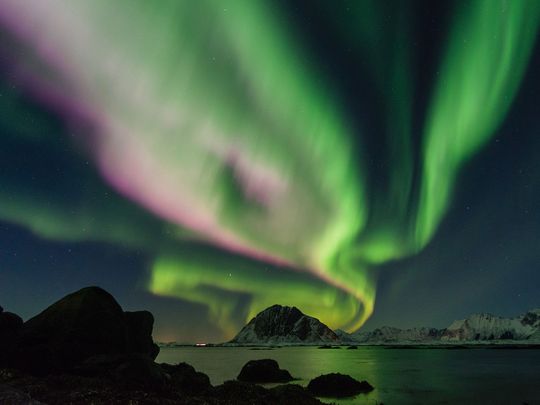
Ever so often, the Earth puts on an otherworldly light show, with a spectacular display of red, green and purplish-blue lights – the aurora borealis and the aurora australis, or the northern and southern lights.
Click start to play the Weekend Crossword, where you can look for space related terms, as the Expo 2020 Dubai Space Week comes to an end. Check out our special coverage of Expo 2020.
The northern lights have been documented as far back as 568 BC, when astronomers during the time of Babylon’s King Nebuchadnezzar II recorded the sighting on a clay tablet. Today, all you need is a space weather report to check if you can travel to a city where the aurora is visible.
When the sun is shining, you’d be hard-pressed to spot an aurora, but the sun is actually the source of these vibrant light displays. By generating a constant stream of charged particles, or plasma, the sun creates a kind of solar wind that slams into the invisible magnetic field surrounding the Earth. Its solar particles collide with gas atoms in the Earth's upper atmosphere, and ‘excite’ them with extra energy, which then gets released as light.
According to the National Geographic, an aurora’s vibrant colours depend on the composition and density of atmospheric gases. At the highest point, 240km above Earth, auroral colours are usually red! But you rarely ever see this colour because it takes almost two minutes for an ‘excited’ oxygen atom to emit a red photon. If the atom collides with another air particle before releasing its light, the red hue may never emerge.
Bright green auroras are the most common – they appear at a height of between 240 to 100km above the planet. Green photons take less than a second to be discharged. And in the thickest part of the lower atmosphere, less than 100km away from the Earth’s surface, a mix of purplish-blue lights can be found – they’re the signature colours of nitrogen.
If conditions are just right, auroras can technically be seen at any time of the year, all around the world. But these light shows are best seen closer to the Earth’s poles, in places like Canada, Scandinavia, Siberia and Antarctica. Spring and fall are the best times to spot the auroras.
But did you know the Earth isn’t the only planet that flaunts its beautiful auroras? Since all the planets in our solar system experience solar winds, all planets with a dense enough atmosphere (and even some moons) can produce auroras. Jupiter and Saturn feature frequent, supersized auroras, while Venus’s lack of a global magnetic field means auroras appear there irregularly.
Have you ever seen the aurora borealis? Play the Weekend Crossword and let us know at games@gulfnews.com.




